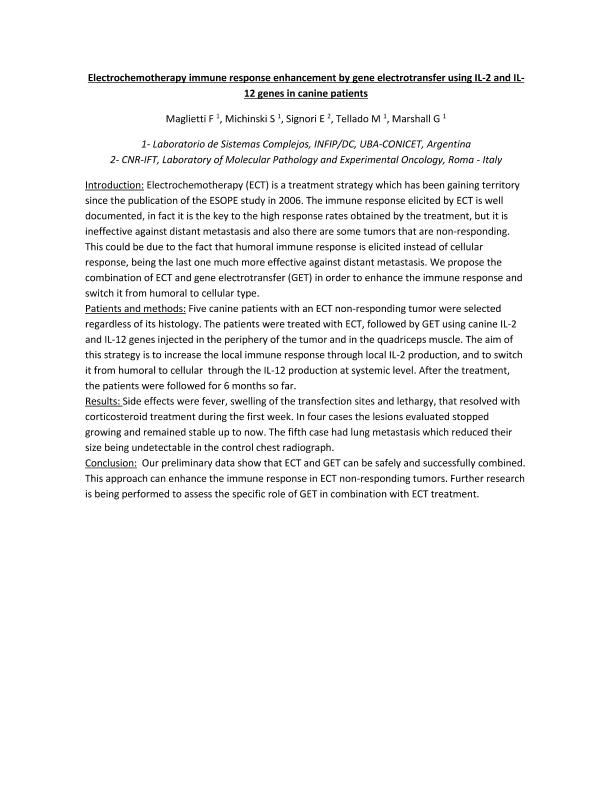Mostrar el registro sencillo del ítem
dc.contributor.author
Maglietti, Felipe Horacio

dc.contributor.author
Michinski, Sebastián Diego

dc.contributor.author
Emanuela, S.
dc.contributor.author
Tellado, Matías Nicolás

dc.contributor.author
Marshall, Guillermo Ricardo

dc.date.available
2018-05-30T17:35:30Z
dc.date.issued
2016-07
dc.identifier.citation
Maglietti, Felipe Horacio; Michinski, Sebastián Diego; Emanuela, S.; Tellado, Matías Nicolás; Marshall, Guillermo Ricardo; Electrochemotherapy immune response enhancement by gene electrotransfer using IL-2 and IL-12 genes in canine patients; Elsevier; European Journal of Cancer; 61; 7-2016; 210
dc.identifier.issn
0959-8049
dc.identifier.uri
http://hdl.handle.net/11336/46666
dc.description.abstract
Introduction: Electrochemotherapy (ECT) is a treatment strategy which has been gaining territory since the publication of the ESOPE study in 2006. The immune response elicited by ECT is well documented, in fact it is the key to the high response rates obtained by the treatment, but it is ineffective against distant metastasis and also there are some tumors that are non-responding. This could be due to the fact that humoral immune response is elicited instead of cellular response, being the last one much more effective against distant metastasis. We propose the combination of ECT and gene electrotransfer (GET) in order to enhance the immune response and switch it from humoral to cellular type. Patients and methods: Five canine patients with an ECT non-responding tumor were selected regardless of its histology. The patients were treated with ECT, followed by GET using canine IL-2 and IL-12 genes injected in the periphery of the tumor and in the quadriceps muscle. The aim of this strategy is to increase the local immune response through local IL-2 production, and to switch it from humoral to cellular through the IL-12 production at systemic level. After the treatment, the patients were followed for 6 months so far. Results: Side effects were fever, swelling of the transfection sites and lethargy, that resolved with corticosteroid treatment during the first week. In four cases the lesions evaluated stopped growing and remained stable up to now. The fifth case had lung metastasis which reduced their size being undetectable in the control chest radiograph. Conclusion: Our preliminary data show that ECT and GET can be safely and successfully combined. This approach can enhance the immune response in ECT non-responding tumors. Further research is being performed to assess the specific role of GET in combination with ECT treatment.
dc.format
application/pdf
dc.language.iso
eng
dc.publisher
Elsevier

dc.rights
info:eu-repo/semantics/openAccess
dc.rights.uri
https://creativecommons.org/licenses/by-nc-sa/2.5/ar/
dc.subject
Ect
dc.subject
Get
dc.subject
Immunotherapy
dc.subject
Cancer
dc.subject.classification
Inmunología

dc.subject.classification
Medicina Básica

dc.subject.classification
CIENCIAS MÉDICAS Y DE LA SALUD

dc.title
Electrochemotherapy immune response enhancement by gene electrotransfer using IL-2 and IL-12 genes in canine patients
dc.type
info:eu-repo/semantics/article
dc.type
info:ar-repo/semantics/artículo
dc.type
info:eu-repo/semantics/publishedVersion
dc.date.updated
2018-05-29T18:36:27Z
dc.journal.volume
61
dc.journal.pagination
210
dc.journal.pais
Países Bajos

dc.journal.ciudad
Amsterdam
dc.description.fil
Fil: Maglietti, Felipe Horacio. Consejo Nacional de Investigaciones Científicas y Técnicas. Oficina de Coordinación Administrativa Ciudad Universitaria. Instituto de Física del Plasma. Universidad de Buenos Aires. Facultad de Ciencias Exactas y Naturales. Instituto de Física del Plasma; Argentina
dc.description.fil
Fil: Michinski, Sebastián Diego. Consejo Nacional de Investigaciones Científicas y Técnicas. Oficina de Coordinación Administrativa Ciudad Universitaria. Instituto de Física del Plasma. Universidad de Buenos Aires. Facultad de Ciencias Exactas y Naturales. Instituto de Física del Plasma; Argentina
dc.description.fil
Fil: Emanuela, S.. Laboratory of Molecular Pathology and Experimental Oncology; Italia
dc.description.fil
Fil: Tellado, Matías Nicolás. Consejo Nacional de Investigaciones Científicas y Técnicas. Oficina de Coordinación Administrativa Ciudad Universitaria. Instituto de Física del Plasma. Universidad de Buenos Aires. Facultad de Ciencias Exactas y Naturales. Instituto de Física del Plasma; Argentina
dc.description.fil
Fil: Marshall, Guillermo Ricardo. Consejo Nacional de Investigaciones Científicas y Técnicas. Oficina de Coordinación Administrativa Ciudad Universitaria. Instituto de Física del Plasma. Universidad de Buenos Aires. Facultad de Ciencias Exactas y Naturales. Instituto de Física del Plasma; Argentina
dc.journal.title
European Journal of Cancer

dc.relation.alternativeid
info:eu-repo/semantics/altIdentifier/doi/https://dx.doi.org/10.1016/S0959-8049(16)61741-0
dc.relation.alternativeid
info:eu-repo/semantics/altIdentifier/url/https://www.sciencedirect.com/science/article/pii/S0959804916617410
Archivos asociados
